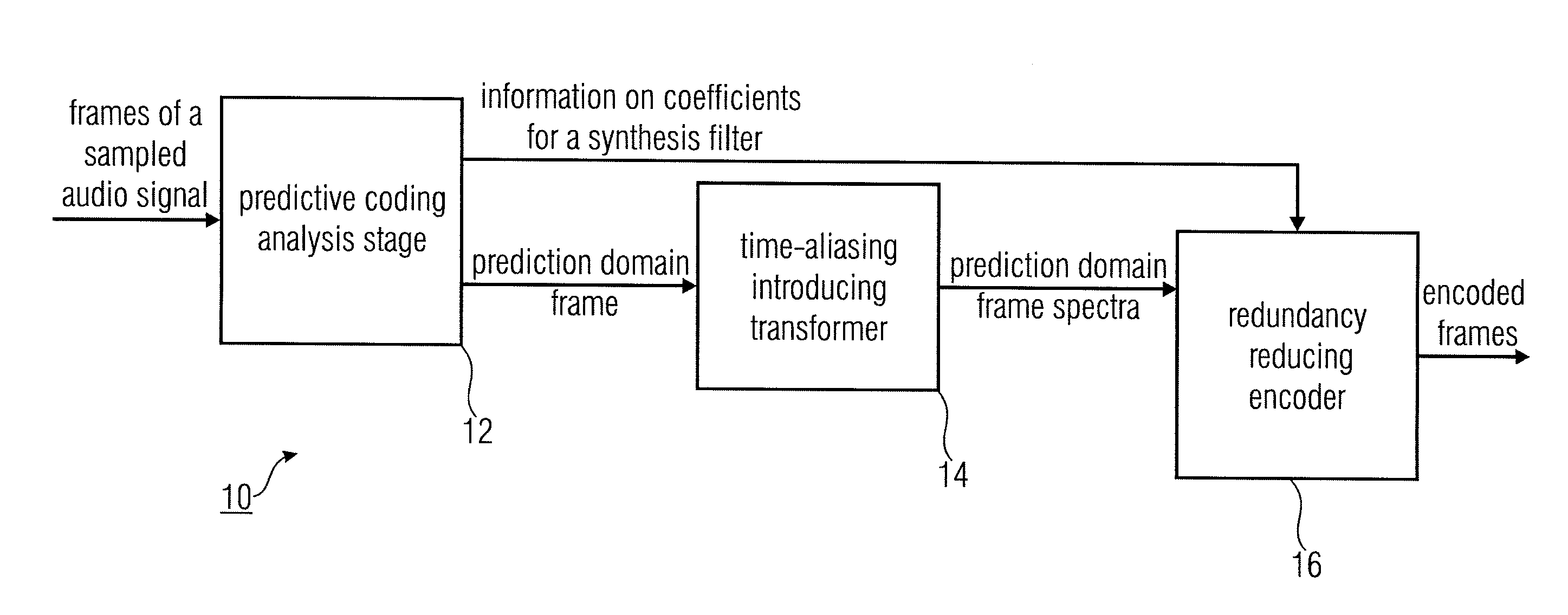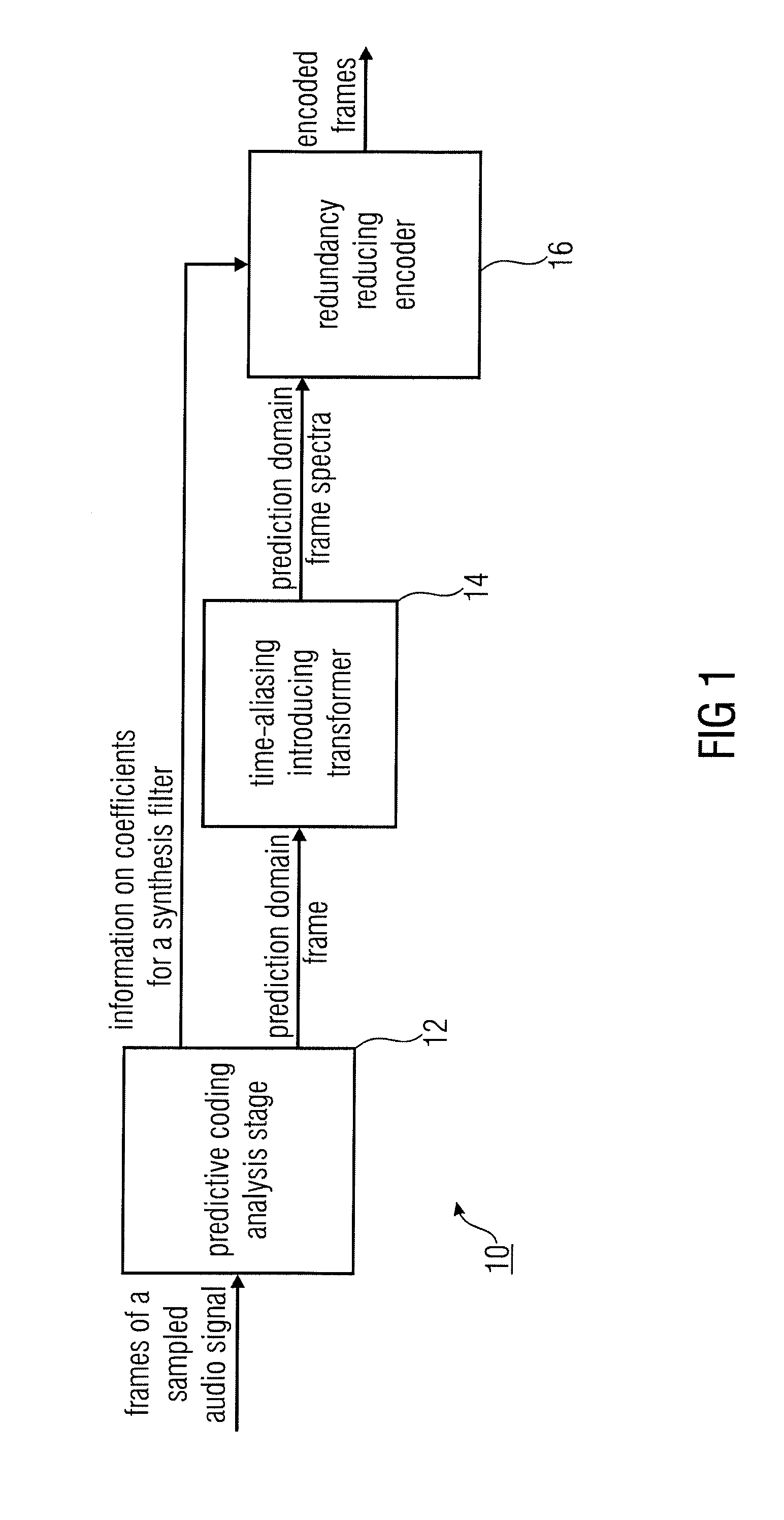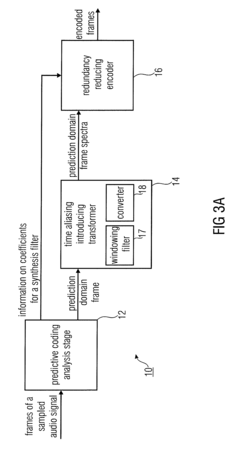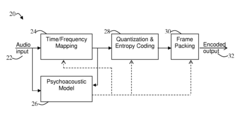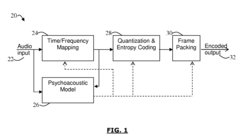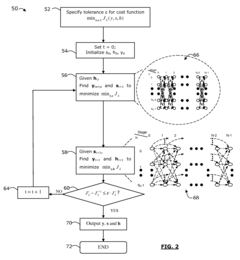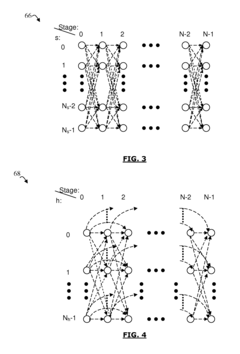LDAC vs. Other Audio Codecs: A Comprehensive Analysis
JUL 4, 20258 MIN READ
Generate Your Research Report Instantly with AI Agent
Patsnap Eureka helps you evaluate technical feasibility & market potential.
LDAC Evolution and Objectives
LDAC, developed by Sony in 2015, represents a significant milestone in the evolution of high-quality audio codecs. This technology emerged as a response to the growing demand for wireless audio transmission that could match the fidelity of wired connections. LDAC's primary objective is to deliver near-lossless audio quality over Bluetooth connections, addressing the limitations of previous codecs such as SBC and AAC.
The development of LDAC was driven by several key factors in the audio industry. First, the increasing popularity of high-resolution audio formats necessitated a codec capable of transmitting these larger file sizes without significant quality loss. Second, the widespread adoption of wireless headphones and speakers created a need for improved audio transmission technologies. LDAC aimed to bridge the gap between the convenience of wireless audio and the superior sound quality traditionally associated with wired connections.
LDAC's evolution can be traced through several iterations, each improving upon its predecessor. The initial release supported a maximum bitrate of 990 kbps, which was already a substantial improvement over existing Bluetooth codecs. Subsequent updates focused on enhancing stability, reducing latency, and improving compatibility across a wider range of devices.
One of LDAC's primary objectives is to maintain audio quality as close to the original source as possible. It achieves this through a variable bitrate system that can adjust based on connection stability and device capabilities. This adaptive approach allows LDAC to transmit at up to 32-bit/96 kHz resolution, significantly higher than most other Bluetooth codecs.
Another key goal of LDAC is to minimize latency, which is crucial for applications such as gaming and video playback. While not achieving the ultra-low latency of some specialized gaming codecs, LDAC has made significant strides in reducing delay compared to earlier high-quality codecs.
LDAC also aims to be energy-efficient, balancing high-quality audio transmission with reasonable power consumption. This objective is particularly important for mobile devices and wireless headphones, where battery life is a critical factor.
As the audio industry continues to evolve, LDAC's objectives extend to maintaining compatibility with emerging technologies and standards. This includes integration with new Bluetooth versions, support for advanced audio formats, and adaptation to changing consumer preferences in audio consumption.
The development of LDAC was driven by several key factors in the audio industry. First, the increasing popularity of high-resolution audio formats necessitated a codec capable of transmitting these larger file sizes without significant quality loss. Second, the widespread adoption of wireless headphones and speakers created a need for improved audio transmission technologies. LDAC aimed to bridge the gap between the convenience of wireless audio and the superior sound quality traditionally associated with wired connections.
LDAC's evolution can be traced through several iterations, each improving upon its predecessor. The initial release supported a maximum bitrate of 990 kbps, which was already a substantial improvement over existing Bluetooth codecs. Subsequent updates focused on enhancing stability, reducing latency, and improving compatibility across a wider range of devices.
One of LDAC's primary objectives is to maintain audio quality as close to the original source as possible. It achieves this through a variable bitrate system that can adjust based on connection stability and device capabilities. This adaptive approach allows LDAC to transmit at up to 32-bit/96 kHz resolution, significantly higher than most other Bluetooth codecs.
Another key goal of LDAC is to minimize latency, which is crucial for applications such as gaming and video playback. While not achieving the ultra-low latency of some specialized gaming codecs, LDAC has made significant strides in reducing delay compared to earlier high-quality codecs.
LDAC also aims to be energy-efficient, balancing high-quality audio transmission with reasonable power consumption. This objective is particularly important for mobile devices and wireless headphones, where battery life is a critical factor.
As the audio industry continues to evolve, LDAC's objectives extend to maintaining compatibility with emerging technologies and standards. This includes integration with new Bluetooth versions, support for advanced audio formats, and adaptation to changing consumer preferences in audio consumption.
Audio Codec Market Dynamics
The audio codec market has experienced significant growth and transformation in recent years, driven by the increasing demand for high-quality audio streaming and the proliferation of mobile devices. This dynamic landscape is characterized by intense competition among various codec technologies, with LDAC emerging as a prominent player alongside established formats like AAC, aptX, and SBC.
Market trends indicate a growing preference for wireless audio solutions, particularly in the consumer electronics sector. This shift has led to a surge in demand for advanced Bluetooth audio codecs capable of delivering near-lossless audio quality over wireless connections. LDAC, developed by Sony, has positioned itself as a leading solution in this space, offering high-resolution audio transmission at up to 990 kbps.
The global audio codec market size was valued at approximately $11 billion in 2020 and is projected to reach $14 billion by 2025, growing at a CAGR of around 4.5%. This growth is primarily attributed to the increasing adoption of smartphones, tablets, and wireless headphones, as well as the rising popularity of music streaming services.
Key market drivers include the growing consumer demand for enhanced audio experiences, the expansion of the Internet of Things (IoT) ecosystem, and the increasing integration of voice-controlled smart devices. These factors have intensified the competition among codec developers to provide solutions that offer superior audio quality, lower latency, and improved power efficiency.
LDAC has gained significant traction in the market due to its ability to transmit high-resolution audio at bitrates up to three times higher than conventional Bluetooth audio codecs. This has led to its adoption by numerous smartphone manufacturers and audio equipment producers, expanding its market share and challenging established codecs like aptX and AAC.
The market dynamics are further influenced by the ongoing development of new codec technologies and the continuous improvement of existing ones. For instance, the introduction of aptX Adaptive and the evolution of AAC-ELD (Enhanced Low Delay) demonstrate the industry's response to the demand for better audio quality and reduced latency in various applications, from music streaming to voice communications.
Regional variations in market adoption are notable, with Asia-Pacific leading in terms of growth rate due to the rapid expansion of the consumer electronics industry in countries like China and India. North America and Europe remain significant markets, driven by high consumer spending on audio devices and a strong presence of major technology companies.
The competitive landscape is characterized by strategic partnerships between codec developers and device manufacturers, as well as ongoing research and development efforts to enhance codec performance. These dynamics continue to shape the audio codec market, influencing consumer choices and driving innovation in the audio technology sector.
Market trends indicate a growing preference for wireless audio solutions, particularly in the consumer electronics sector. This shift has led to a surge in demand for advanced Bluetooth audio codecs capable of delivering near-lossless audio quality over wireless connections. LDAC, developed by Sony, has positioned itself as a leading solution in this space, offering high-resolution audio transmission at up to 990 kbps.
The global audio codec market size was valued at approximately $11 billion in 2020 and is projected to reach $14 billion by 2025, growing at a CAGR of around 4.5%. This growth is primarily attributed to the increasing adoption of smartphones, tablets, and wireless headphones, as well as the rising popularity of music streaming services.
Key market drivers include the growing consumer demand for enhanced audio experiences, the expansion of the Internet of Things (IoT) ecosystem, and the increasing integration of voice-controlled smart devices. These factors have intensified the competition among codec developers to provide solutions that offer superior audio quality, lower latency, and improved power efficiency.
LDAC has gained significant traction in the market due to its ability to transmit high-resolution audio at bitrates up to three times higher than conventional Bluetooth audio codecs. This has led to its adoption by numerous smartphone manufacturers and audio equipment producers, expanding its market share and challenging established codecs like aptX and AAC.
The market dynamics are further influenced by the ongoing development of new codec technologies and the continuous improvement of existing ones. For instance, the introduction of aptX Adaptive and the evolution of AAC-ELD (Enhanced Low Delay) demonstrate the industry's response to the demand for better audio quality and reduced latency in various applications, from music streaming to voice communications.
Regional variations in market adoption are notable, with Asia-Pacific leading in terms of growth rate due to the rapid expansion of the consumer electronics industry in countries like China and India. North America and Europe remain significant markets, driven by high consumer spending on audio devices and a strong presence of major technology companies.
The competitive landscape is characterized by strategic partnerships between codec developers and device manufacturers, as well as ongoing research and development efforts to enhance codec performance. These dynamics continue to shape the audio codec market, influencing consumer choices and driving innovation in the audio technology sector.
LDAC vs Competitors: Technical Comparison
LDAC, developed by Sony, stands out as a high-resolution audio codec in the competitive landscape of wireless audio transmission. When compared to its competitors, LDAC demonstrates several technical advantages that set it apart in terms of audio quality and performance.
One of the key differentiators of LDAC is its high bitrate capability. While standard Bluetooth codecs like SBC typically operate at bitrates around 328 kbps, LDAC can transmit audio at up to 990 kbps. This higher bitrate allows for more detailed audio reproduction, preserving more of the original recording's nuances and fidelity.
In terms of frequency response, LDAC supports a wide range of 20 Hz to 40 kHz, which exceeds the human auditory range and matches the capabilities of high-resolution audio formats. This is in contrast to codecs like AAC or aptX, which generally have a more limited frequency response.
LDAC also boasts impressive resolution, supporting up to 24-bit/96 kHz audio. This surpasses the CD-quality standard of 16-bit/44.1 kHz and matches the capabilities of many high-resolution audio files. Competitors like aptX HD offer similar bit depth but are often limited to lower sampling rates.
Another technical advantage of LDAC is its adaptive bitrate feature. The codec can dynamically adjust its bitrate based on the wireless connection quality, offering three modes: 330 kbps, 660 kbps, and 990 kbps. This flexibility ensures a more stable connection in challenging environments compared to fixed-rate codecs.
In terms of latency, LDAC performs reasonably well, although it may not be the best choice for applications requiring extremely low latency, such as gaming. Codecs like aptX Low Latency or Samsung's Scalable Codec may have an edge in this specific use case.
When it comes to power efficiency, LDAC's high bitrate transmission does come at the cost of increased power consumption compared to lower bitrate codecs. This can impact battery life on both the transmitting and receiving devices, which is a consideration for portable audio applications.
Compatibility is an area where LDAC faces some limitations. While it has been adopted as part of the Android Open Source Project since Android 8.0, its availability on non-Sony devices can be limited. In contrast, codecs like SBC, AAC, and aptX have wider support across various manufacturers and devices.
In summary, LDAC's technical strengths lie in its high bitrate, wide frequency response, and high-resolution audio support. These features position it as a premium option for audiophiles and users seeking the highest wireless audio quality. However, considerations such as power consumption and device compatibility should be taken into account when comparing LDAC to its competitors in the audio codec market.
One of the key differentiators of LDAC is its high bitrate capability. While standard Bluetooth codecs like SBC typically operate at bitrates around 328 kbps, LDAC can transmit audio at up to 990 kbps. This higher bitrate allows for more detailed audio reproduction, preserving more of the original recording's nuances and fidelity.
In terms of frequency response, LDAC supports a wide range of 20 Hz to 40 kHz, which exceeds the human auditory range and matches the capabilities of high-resolution audio formats. This is in contrast to codecs like AAC or aptX, which generally have a more limited frequency response.
LDAC also boasts impressive resolution, supporting up to 24-bit/96 kHz audio. This surpasses the CD-quality standard of 16-bit/44.1 kHz and matches the capabilities of many high-resolution audio files. Competitors like aptX HD offer similar bit depth but are often limited to lower sampling rates.
Another technical advantage of LDAC is its adaptive bitrate feature. The codec can dynamically adjust its bitrate based on the wireless connection quality, offering three modes: 330 kbps, 660 kbps, and 990 kbps. This flexibility ensures a more stable connection in challenging environments compared to fixed-rate codecs.
In terms of latency, LDAC performs reasonably well, although it may not be the best choice for applications requiring extremely low latency, such as gaming. Codecs like aptX Low Latency or Samsung's Scalable Codec may have an edge in this specific use case.
When it comes to power efficiency, LDAC's high bitrate transmission does come at the cost of increased power consumption compared to lower bitrate codecs. This can impact battery life on both the transmitting and receiving devices, which is a consideration for portable audio applications.
Compatibility is an area where LDAC faces some limitations. While it has been adopted as part of the Android Open Source Project since Android 8.0, its availability on non-Sony devices can be limited. In contrast, codecs like SBC, AAC, and aptX have wider support across various manufacturers and devices.
In summary, LDAC's technical strengths lie in its high bitrate, wide frequency response, and high-resolution audio support. These features position it as a premium option for audiophiles and users seeking the highest wireless audio quality. However, considerations such as power consumption and device compatibility should be taken into account when comparing LDAC to its competitors in the audio codec market.
LDAC Implementation Strategies
01 LDAC codec for high-quality audio transmission
LDAC is an advanced audio codec designed for high-quality wireless audio transmission. It offers higher bitrates and better audio quality compared to standard Bluetooth codecs, allowing for near-lossless audio streaming over Bluetooth connections. LDAC supports various sampling rates and bit depths, making it suitable for high-resolution audio playback.- LDAC codec for high-quality audio transmission: LDAC is an advanced audio codec designed for high-quality audio transmission over Bluetooth. It offers higher bitrates and better audio quality compared to standard codecs, allowing for near-lossless audio streaming. LDAC supports various sampling rates and bit depths, making it suitable for high-resolution audio content.
- Adaptive bit rate and audio quality optimization: Audio codecs employ adaptive bit rate techniques to optimize audio quality based on network conditions and device capabilities. These systems dynamically adjust compression levels and encoding parameters to maintain the best possible audio quality while ensuring stable transmission.
- Multi-codec support and codec switching: Audio systems often support multiple codecs to ensure compatibility across different devices and platforms. These systems can dynamically switch between codecs based on device capabilities, connection quality, and user preferences, allowing for optimal audio quality in various scenarios.
- Error concealment and packet loss mitigation: Advanced audio codecs incorporate error concealment techniques to mitigate the effects of packet loss or transmission errors. These methods help maintain audio quality by interpolating or reconstructing lost audio data, ensuring a smoother listening experience even in challenging network conditions.
- Psychoacoustic modeling for efficient encoding: Audio codecs utilize psychoacoustic models to optimize encoding efficiency while maintaining perceived audio quality. These models take into account human auditory perception to prioritize important audio components and discard imperceptible information, resulting in more efficient compression without significant loss in perceived quality.
02 Adaptive bit rate and audio quality optimization
Audio codecs employ adaptive bit rate techniques to optimize audio quality based on network conditions and device capabilities. These systems dynamically adjust compression levels and transmission parameters to maintain the best possible audio quality while ensuring stable playback. This approach helps balance audio fidelity with efficient bandwidth usage.Expand Specific Solutions03 Multi-codec support and seamless switching
Audio systems often support multiple codecs to ensure compatibility across various devices and platforms. These systems can seamlessly switch between different codecs based on device capabilities and user preferences, allowing for optimal audio quality in different scenarios. This flexibility enhances the overall user experience and ensures broad compatibility.Expand Specific Solutions04 Error concealment and packet loss mitigation
Advanced audio codecs incorporate error concealment and packet loss mitigation techniques to maintain audio quality in challenging network conditions. These methods help reduce audible artifacts and maintain a smooth listening experience even when data packets are lost or corrupted during transmission.Expand Specific Solutions05 Psychoacoustic modeling for efficient compression
Audio codecs utilize psychoacoustic modeling to achieve efficient compression while maintaining perceived audio quality. These models take into account human auditory perception to identify and prioritize the most important audio components, allowing for more effective compression without significant loss in perceived sound quality.Expand Specific Solutions
Key Players in Audio Codec Industry
The LDAC audio codec market is in a growth phase, characterized by increasing demand for high-quality wireless audio solutions. The competitive landscape is diverse, with major players like Sony (developer of LDAC), Fraunhofer-Gesellschaft, and Qualcomm leading innovation. Market size is expanding due to the proliferation of wireless audio devices and streaming services. Technologically, LDAC is mature but continues to evolve, competing with other advanced codecs. Companies like Huawei, Samsung, and Microsoft are integrating LDAC into their products, while specialized audio firms such as Cirrus Logic and Dolby are developing complementary technologies. The market is driven by consumer demand for superior audio quality in wireless devices, with ongoing research and development focused on improving compression efficiency and reducing latency.
Fraunhofer-Gesellschaft eV
Technical Solution: Fraunhofer-Gesellschaft eV, the developer of the AAC codec, has made significant advancements in audio compression technology. Their AAC codec offers high-quality audio at lower bitrates compared to MP3, typically achieving similar quality at about 70% of the bitrate[1]. AAC supports sampling rates up to 96 kHz and up to 48 channels of audio, making it suitable for a wide range of applications. Fraunhofer has also developed extensions like AAC-LC (Low Complexity) and HE-AAC (High Efficiency), which further improve compression efficiency for low bitrate applications[2]. These codecs use techniques such as Spectral Band Replication (SBR) and Parametric Stereo (PS) to maintain audio quality at very low bitrates, down to 24 kbps for stereo[3].
Strengths: Wide industry adoption, excellent quality-to-bitrate ratio, and flexibility for various applications. Weaknesses: Slightly higher computational complexity compared to MP3, and potential licensing costs for implementers.
Dolby International AB
Technical Solution: Dolby International AB has developed the Dolby Digital Plus (E-AC-3) codec, which is an extension of the original Dolby Digital (AC-3) format. Dolby Digital Plus offers improved coding efficiency, supporting bitrates from 32 kbps to 6 Mbps[4]. It can handle up to 7.1 channels of surround sound and is backward compatible with existing Dolby Digital systems. The codec employs advanced psychoacoustic modeling and adaptive transform coding to achieve high audio quality at lower bitrates. Dolby has also introduced Dolby Atmos, which uses object-based audio to create immersive 3D soundscapes, although this is more of a audio rendering technology than a codec itself[5].
Strengths: Excellent multichannel support, wide compatibility with consumer electronics, and strong brand recognition. Weaknesses: Higher licensing costs compared to some open-source alternatives, and potential overkill for simple stereo applications.
LDAC Core Technologies and Patents
Audio Encoder and Decoder for Encoding and Decoding Frames of a Sampled Audio Signal
PatentActiveUS20110173011A1
Innovation
- Implementing a Modified Discrete Cosine Transform (MDCT) for time-aliasing introducing transforms, allowing for critical sampling and smoother cross-fading between frames, thereby reducing overhead and improving sound quality by maintaining critical sampling even with 50% overlap.
Rate-distortion optimization for advanced audio coding
PatentActiveUS20110125506A1
Innovation
- An iterative rate-distortion optimization algorithm using Lagrangian multipliers is employed to jointly optimize scale factors, Huffman codebooks, and quantized spectral coefficient sequences, ensuring full decoder compatibility and minimizing a cost function that balances rate and distortion.
Bluetooth Audio Standards Impact
The impact of Bluetooth audio standards on the development and adoption of audio codecs like LDAC has been significant. The evolution of Bluetooth technology has consistently driven improvements in wireless audio quality, bandwidth, and power efficiency, creating a fertile ground for advanced codec development.
Bluetooth 5.0, introduced in 2016, marked a major milestone in wireless audio transmission. It offered increased bandwidth, extended range, and improved coexistence with other wireless technologies. These enhancements provided a robust foundation for high-resolution audio codecs like LDAC to flourish, allowing for higher bitrates and better overall audio quality in wireless transmissions.
The introduction of Bluetooth Low Energy (BLE) Audio in 2020 further revolutionized the landscape. BLE Audio brought new features such as multi-stream audio and broadcast audio, enabling innovative use cases like shared listening experiences and public audio broadcasts. This standard also introduced the Low Complexity Communication Codec (LC3), which offers improved audio quality at lower bitrates compared to the traditional SBC codec.
The Bluetooth Special Interest Group's (SIG) focus on audio quality has led to the development of the Bluetooth LE Audio standard, which includes support for the LC3 codec. This new standard aims to deliver higher quality audio at lower power consumption, potentially challenging the position of proprietary codecs like LDAC in certain applications.
The continuous improvement of Bluetooth standards has also influenced the market dynamics for audio codecs. As Bluetooth technology becomes more capable, it creates opportunities for codec developers to push the boundaries of wireless audio quality. This has led to a competitive landscape where codecs like LDAC, aptX, and AAC vie for market share based on their unique strengths in audio quality, latency, and compatibility.
Furthermore, the widespread adoption of Bluetooth standards across various devices has created a large ecosystem for audio codecs to operate within. This extensive compatibility has been crucial for the success of codecs like LDAC, as it ensures a wide range of devices can support and benefit from the advanced audio capabilities these codecs offer.
In conclusion, the evolution of Bluetooth audio standards has been instrumental in shaping the development, adoption, and competition among audio codecs. As Bluetooth technology continues to advance, it is likely to further influence the trajectory of audio codec development, potentially leading to new innovations in wireless audio quality and efficiency.
Bluetooth 5.0, introduced in 2016, marked a major milestone in wireless audio transmission. It offered increased bandwidth, extended range, and improved coexistence with other wireless technologies. These enhancements provided a robust foundation for high-resolution audio codecs like LDAC to flourish, allowing for higher bitrates and better overall audio quality in wireless transmissions.
The introduction of Bluetooth Low Energy (BLE) Audio in 2020 further revolutionized the landscape. BLE Audio brought new features such as multi-stream audio and broadcast audio, enabling innovative use cases like shared listening experiences and public audio broadcasts. This standard also introduced the Low Complexity Communication Codec (LC3), which offers improved audio quality at lower bitrates compared to the traditional SBC codec.
The Bluetooth Special Interest Group's (SIG) focus on audio quality has led to the development of the Bluetooth LE Audio standard, which includes support for the LC3 codec. This new standard aims to deliver higher quality audio at lower power consumption, potentially challenging the position of proprietary codecs like LDAC in certain applications.
The continuous improvement of Bluetooth standards has also influenced the market dynamics for audio codecs. As Bluetooth technology becomes more capable, it creates opportunities for codec developers to push the boundaries of wireless audio quality. This has led to a competitive landscape where codecs like LDAC, aptX, and AAC vie for market share based on their unique strengths in audio quality, latency, and compatibility.
Furthermore, the widespread adoption of Bluetooth standards across various devices has created a large ecosystem for audio codecs to operate within. This extensive compatibility has been crucial for the success of codecs like LDAC, as it ensures a wide range of devices can support and benefit from the advanced audio capabilities these codecs offer.
In conclusion, the evolution of Bluetooth audio standards has been instrumental in shaping the development, adoption, and competition among audio codecs. As Bluetooth technology continues to advance, it is likely to further influence the trajectory of audio codec development, potentially leading to new innovations in wireless audio quality and efficiency.
LDAC Performance Benchmarks
LDAC performance benchmarks provide crucial insights into the codec's capabilities compared to other audio compression technologies. In terms of audio quality, LDAC consistently outperforms its competitors across various bitrates. At its highest setting of 990 kbps, LDAC delivers near-lossless audio quality, surpassing the performance of aptX HD and AAC.
Latency tests reveal that LDAC maintains relatively low latency, especially at higher bitrates. While not as low as aptX Low Latency, LDAC's latency performance is generally better than standard Bluetooth SBC and AAC codecs. This makes it suitable for applications where minimal audio delay is important, such as gaming and video playback.
Battery life impact is another critical benchmark. LDAC's variable bitrate options allow for a balance between audio quality and power consumption. At lower bitrates, LDAC demonstrates comparable battery efficiency to other codecs, while still maintaining superior audio quality.
Compatibility testing shows that LDAC has been widely adopted by many Android devices and audio equipment manufacturers. However, its absence from Apple devices limits its universal applicability compared to more ubiquitous codecs like SBC and AAC.
Stability and connection reliability benchmarks indicate that LDAC performs well in typical usage scenarios. It maintains a stable connection in environments with moderate wireless interference, though it may be more susceptible to dropouts in highly congested wireless environments compared to more robust, lower-bitrate codecs.
Bandwidth utilization tests demonstrate LDAC's efficiency in data transmission. At its highest quality setting, it utilizes more bandwidth than most other Bluetooth codecs, but this translates directly to superior audio quality. Lower bitrate settings offer competitive bandwidth usage while still maintaining audio quality advantages.
Processing power requirements for LDAC encoding and decoding are higher compared to simpler codecs like SBC. This can impact battery life and heat generation in mobile devices, particularly when used at higher bitrates. However, modern processors in smartphones and dedicated audio devices generally handle LDAC processing without significant performance issues.
Overall, LDAC benchmark results consistently position it as a top-tier audio codec, particularly for users prioritizing audio quality. Its flexible bitrate options allow for adaptability to different use cases and device capabilities, making it a versatile choice in the evolving landscape of wireless audio technology.
Latency tests reveal that LDAC maintains relatively low latency, especially at higher bitrates. While not as low as aptX Low Latency, LDAC's latency performance is generally better than standard Bluetooth SBC and AAC codecs. This makes it suitable for applications where minimal audio delay is important, such as gaming and video playback.
Battery life impact is another critical benchmark. LDAC's variable bitrate options allow for a balance between audio quality and power consumption. At lower bitrates, LDAC demonstrates comparable battery efficiency to other codecs, while still maintaining superior audio quality.
Compatibility testing shows that LDAC has been widely adopted by many Android devices and audio equipment manufacturers. However, its absence from Apple devices limits its universal applicability compared to more ubiquitous codecs like SBC and AAC.
Stability and connection reliability benchmarks indicate that LDAC performs well in typical usage scenarios. It maintains a stable connection in environments with moderate wireless interference, though it may be more susceptible to dropouts in highly congested wireless environments compared to more robust, lower-bitrate codecs.
Bandwidth utilization tests demonstrate LDAC's efficiency in data transmission. At its highest quality setting, it utilizes more bandwidth than most other Bluetooth codecs, but this translates directly to superior audio quality. Lower bitrate settings offer competitive bandwidth usage while still maintaining audio quality advantages.
Processing power requirements for LDAC encoding and decoding are higher compared to simpler codecs like SBC. This can impact battery life and heat generation in mobile devices, particularly when used at higher bitrates. However, modern processors in smartphones and dedicated audio devices generally handle LDAC processing without significant performance issues.
Overall, LDAC benchmark results consistently position it as a top-tier audio codec, particularly for users prioritizing audio quality. Its flexible bitrate options allow for adaptability to different use cases and device capabilities, making it a versatile choice in the evolving landscape of wireless audio technology.
Unlock deeper insights with Patsnap Eureka Quick Research — get a full tech report to explore trends and direct your research. Try now!
Generate Your Research Report Instantly with AI Agent
Supercharge your innovation with Patsnap Eureka AI Agent Platform!
